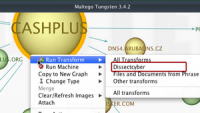-
NHS ransomware cyber-attack was preventable

In a matter of hours, the NHS was effectively placed on lockdown with computer systems being held ransom and further machines powered down to prevent the spread of malware. Critical patient information has been inaccessible and several hospitals urged people to avoid accident and emergency departments, except in cases of real emergencies. But it is not just British infrastructure that has been affected by the ransomware. A total of 99 countries have suffered from this attack so far. Modern anti-virus software and up-to-date operating systems can only do so much. It is therefore vital to invest more in cyber-security training for all staff working with sensitive information. This attack proves that the UK’s cybers-security policy needs further work.
-
-
Educating, strengthening the cybersecurity workforce
As Americans become more dependent on modern technology, the demand to protect the nation’s digital infrastructure will continue to grow. CSU, designated as Centers of Academic Excellence in Information Assurance by the NSA and DHS, says that in an effort to produce career-ready cybersecurity professionals and to combat cybercrime nationwide, the California State University is creating educational opportunities for students and faculty members.
-
-
U.K. hospitals, clinics hit by large-scale ransomware cyberattack
The NHS has confirmed that hospitals across England have been hit by a large-scale cyberattack. The attack has locked staff out of their computers and forced emergency patients to be diverted to hospitals not hit by the attack. The IT systems of NHS facilities across England have been hit simultaneously – and the screens of computers connected to the networks under attack showed a pop-up message demanding a ransom in exchange for allowing staff access to the PCs.
-
-
Bypassing encryption: “Lawful hacking” is the next frontier of law enforcement technology
The discussion about how law enforcement or government intelligence agencies might rapidly decode information someone else wants to keep secret is – or should be – shifting. One commonly proposed approach, introducing what is called a “backdoor” to the encryption algorithm itself, is now widely recognized as too risky to be worth pursuing any further. The scholarly and research community, the technology industry and Congress appear to be in agreement that weakening the encryption that in part enables information security – even if done in the name of public safety or national security – is a bad idea. Backdoors could be catastrophic, jeopardizing the security of billions of devices and critical communications. A lawful hacking approach offers a solution that appears to gain greater favor with experts than encryption backdoors. A group of scholars proposed some ways we should begin thinking about how law enforcement could hack. Agencies are already doing it, so it’s time to turn from the now-ended debate about encryption backdoors and engage in this new discussion instead.
-
-
Cyber Security R&D Showcase coming in July
The 2017 Cyber Security R&D Showcase and Technical Workshop is scheduled for 11-13 July at Washington, D.C.’s Mayflower Hotel. In all, fifteen research areas will be featured: mobile security, cyber-physical system security, software assurance, data privacy, identity management, distributed denial of service defense, next generation cyber infrastructure, technology transition, cyber risk economics, cybersecurity research infrastructure, modeling of internet attacks, support for law enforcement, moving-target defense, cloud security and insider threats. During the conference, attendees can choose from more than 115 technical presentations representing a combined $250 million of federally funded R&D.
-
-
New meter to change how users create passwords
One of the most popular passwords in 2016 was “qwertyuiop,” even though most password meters will tell say it is a weak choice. The problem is that no existing meters offer any good advice to make it better — until now. Researchers have unveiled a new, state-of-the-art password meter that offers real-time feedback and advice to help people create better passwords. To evaluate its performance, the team conducted an online study in which they asked 4,509 people to use the meter to create a password.
-
-
Why we choose terrible passwords, and how to fix them

The first Thursday in May is World Password Day, but don’t buy a cake or send cards. Computer chip maker Intel created the event as an annual reminder that, for most of us, our password habits are nothing to celebrate. Instead, they – and computer professionals like me – hope we will use this day to say our final goodbyes to “qwerty” and “123456,” which are still the most popular passwords. So no more excuses. Let’s put on our party hats and start changing those passwords. World Password Day would be a great time to ditch “qwerty” for good, try out a password manager and turn on multi-factor authentication. Once you’re done, go ahead and have that cake, because you’ll deserve it.
-
-
Dissect Cyber notifies small businesses targeted by cybercriminals

Cybercriminals are an insidious lot, constantly launching new schemes to steal money from individuals and companies. In the United States, millions of people and small businesses fall victim to internet crimes each year. Most small businesses do not have ready access to timely cybersecurity notifications of possible threats.
-
-
Russia’s hacking, disinformation efforts aim to influence German, French elections

Russian government hackers and disinformation specialists were successful in their hacking and disinformation campaign in the run-up to the November 2016 election in the United States. “I think one of the lessons that the Russians may have drawn from this is that this works,” FBI director James Comey told lawmakers on Tuesday. German and French intelligence services agree with Comey. They say they have detected an intensification of Russian hacking and disinformation efforts in the run-up of the second round of France’s presidential election – to be held this coming Sunday – and Germany’s federal election, to be held in September. In both Francde and Germany, Russia’s campaign aims to strengthen populist, far-right, ultra-nationalist, and anti-American politicians and parties.
-
-
The lessons on Russian intelligence
Despite President Trump’s saying that it’s all just “fake news,” James R. Clapper, who was U.S. director of national intelligence from 2010 until January, said he has no doubt that Russia successfully interfered in the 2016 election and “clearly favored” Trump over Hillary Clinton. “Clearly, the Russians — and the shots were called at the highest level — were interested first in sowing dissension and doubt and discord in this country,” Clapper said. As the campaign went on, however, he said their aims switched to helping Trump. “They, too, didn’t initially take Mr. Trump seriously, but later on they did,” Clapper said at a Harvard Kennedy School talk. Clapper said we should expect more Russian meddling in U.S. elections.
-
-
The Darknet offers more robust protection against attacks

Researchers have discovered why cyberattacks usually fail against the Darknet, a part of the internet that guarantees users’ privacy and anonymity. This hidden network is used for sensitive and often illegal purposes such as drug trafficking or exchanging child pornography and can counter large attacks on its own by spontaneously adding more network capacity.
-
-
Online security won’t improve until companies stop passing the buck to the customer
It’s normally in the final seconds of a TV or radio interview that security experts get asked for advice for the general public – something simple, unambiguous, and universally applicable. It’s a fair question, and what the public want. But simple answers are usually wrong, and can do more harm than good. Customers do want to protect themselves, and there is a clear demand for good security advice. But this advice needs to be realistic, needs to consider that different individuals have different circumstances that require different approaches, and put the interests of the customer first. Companies that develop security systems are in the best position to improve security, and they must take responsibility for doing so by learning from the research that reveals how individuals really use, understand, and misunderstand security technology.
-
-
Machine-learning-based solution to help combat phishing

When it comes to hacking, phishing is one of the oldest tricks in the book. According to IBM security research, some 30 percent of phishing e-mails are opened by targeted recipients. Additionally, the attacks are becoming more advanced and harder to detect at first glance. A new machine-learning-based security solution could help businesses detect phishing sites up to 250 percent faster than other methods.
-
-
Cyber attacks ten years on: from disruption to disinformation
Today – 27 April — marks the tenth anniversary of the world’s first major coordinated “cyberattack” on a nation’s internet infrastructure: Russian government hackers attacked the computer systems of the government of Estonia in retaliation for what Russia considered to be an insult to the sacrifices of the Red Army during the Second World War. This little-known event set the scene for the onrush of cyber espionage, fake news, and information wars we know today. A cybersecurity expert recently told the Senate Select Committee on Intelligence that to understand current Russian active measures and influence campaigns — that is, to understand cyber operations in the twenty-first century – we must first understand intelligence operations in the twentieth century. Understanding the history of cyber operations will be critical for developing strategies to combat them. Narrowly applying models from military history and tactics will offer only specific gains in an emerging ecosystem of “information age strategies.” If nations wish to defend themselves, they will need to understand culture as much as coding.
-
-
Cybersecurity firm trains students for high-tech heroics
With newscasts regularly portraying a menacing picture of cybercrime, Indiana State University Professor Bill Mackey — and the students he teaches — is almost guaranteed job security. Perhaps the biggest news story this spring involves the Russians, the Democratic National Committee and, possibly, the Trump White House. It also involves exactly the focus of Mackey and his cyber security company, Alloy. Preventing the human missteps is exactly what Mackey’s enterprise does that’s different from almost everyone else: They marry the technological part (the computer-code breaking) with the human element for a mixture of tech and cybercriminology.
-
- All
- Regional
- Water
- Biometrics
- Borders/Immig
- Business
- Cybersecurity
- Detection
- Disasters
- Government
- Infrastructure
- International
- Public health
- Public Safety
- Communication interoperabillity
- Emergency services
- Emergency medical services
- Fire
- First response
- IEDs
- Law Enforcement
- Law Enforcement Technology
- Military technology
- Nonlethal weapons
- Nuclear weapons
- Personal protection equipment
- Police
- Notification /alert systems
- Situational awareness
- Weapons systems
- Sci-Tech
- Sector Reports
- Surveillance
- Transportation
Advertising & Marketing: advertise@newswirepubs.com
Editorial: editor@newswirepubs.com
General: info@newswirepubs.com
2010-2011 © News Wire Publications, LLC News Wire Publications, LLC
220 Old Country Road | Suite 200 | Mineola | New York | 11501
Permissions and Policies
Editorial: editor@newswirepubs.com
General: info@newswirepubs.com
2010-2011 © News Wire Publications, LLC News Wire Publications, LLC
220 Old Country Road | Suite 200 | Mineola | New York | 11501
Permissions and Policies
